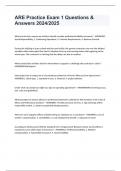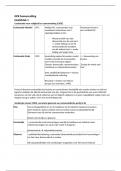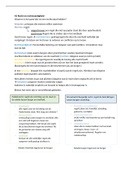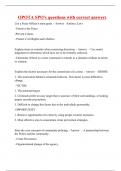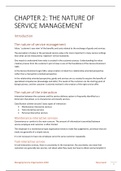Ledger
The Accounting Equation!!!
Assets = Owner’s Equity + Liablilities
Increase on Debit (Dr) Side Increase on Credit (Cr) Side
Expenses Liabilities
Assets Income
Drawings Capital
Double Entry!!
What you put on one side, you put on the other…
, Opening Balances in the General Ledger:
It is important to take note of the fact that an existing business (not the
first month of doing business) will already have balances b/d in the
General Ledger from the previous month. It is then important to start the
current moth’s General Ledger with these amounts.
In the Balance Sheet section these amounts are referred to as ‘Balances
b/d’ (brought down) while in the Nominal Accounts section they are
referred to as ‘Total b/d’.
To determine which side the balance should be on, use the rules CLIC
and DEAD…
DEAD: CLIC:
D = Debit C = Credit
E = Expenses L = Liabilities
A = Assets I = Income
D = Drawings C = Capital
*These only apply to balances!!*
Example of an Opening Balance:
Barnes Traders had an opening balance of R100 000 on the 1st October 2013.
General Ledger of Barnes Traders
Balance Sheet Section
Bank B1
2013 2013 Total
1 Balance b/d 100 000 - 31 CPJ 150 000 -
Oct Oct Payments
Total
31 CRJ 200 000 - Balance c/d 150 000 -
Receipts
300 000 - 300 000 -
Nov 1 Balance b/d 150 000 -
m 1
, Posting to the General Ledger for a Service
Undertaking:
1. The Cash Receipts Journal (CRJ) is used to record all money (cash)
received by the business. The Cash Payments Journal (CPJ) is used
to record all money (cash) paid by the business.
2. At the end of the month the subsidiary books (journals) have to be
added up and all transactions posted to the General Ledger.
a. The total of the columns are posted as one amount and the
Folio number written under the column. The last day of the
month is always used as the date in the General Ledger.
b. All transactions recorded in the ‘Sundry’ column have to be
posted as individual transactions and the Folio numbers
recorded next to each Sundry entry in the ‘Folio’ column. The
date on which the transaction took place is used in the
General Ledger.
3. The General Ledger is always started with the ‘Balance Sheet
Section’. Capital, Drawings, Assets and Liabilities are recorded in
the Balance Sheet Section.
4. The second part of the General Ledger will contain the ‘Nominal
Accounts Section’. All Income and Expenses are posted to the
Nominal Accounts Section.
5. The General Ledger has ‘two sides’, i.e. a Debit (left) side and a
Credit (right) side.
6. These are the ‘Golden Rules For Accounts’ when Posting to the
General Ledger:
Balance Sheet Accounts:
Assets increase Debit Assets decrease Credit
Liabilities decrease Debit Liabilities increase Credit
Owner’s Equity Debit Owner’s Equity Credit
decreases increases
Nominal Accounts:
Expenses increase Debit Expenses decrease Credit
Income decreases Debit Income increases Credit
m 2
, 7. The ‘Bank’ account will have an entry on both the debit and credit
sides (CRJ means we are receiving money and therefor Bank is
increasing on the debit side with total receipts while the CPJ
means we are paying money and Bank has therefor to decrease on
the credit side with total payments).
8. At the end of the month the totalled bank columns of the CPJ and
CRJ must be posted to the General Ledger.
9. CPJ means that money is coming out of the bank account, which
means the bank account must be credited on the credit side. CRJ
means that money is going into the bank account, which means
the bank account must be debited on the debit side.
Example of Posting to a General Ledger:
Cash Receipts Journal of Ndlovu Tailors for October 2014 CRJ 1
Analysis of Current Sundry
Doc D Details Fol Bank Fol Details
Receipts Income Amount
R001 1 Mrs. Ndlovu 200 000 - 200 000 - - 200 000 - B1` Capital
Services
CRR 4 12 000 - 12 000 - 12 000 -
Rendered
Services
CRR 6 4 500 - 4 500 -
rendered
Rent
R002 Hilda Cronje 2 220 - 6 720 - 220 000 - N2
Income
R003 11 Mrs. Ndlovu 205 000 - 205 000 - 205 000 - B1 Capital
Services
CRR 24 6 890 - 6 890 - 6 890 -
Rendered
430 610 - 23 390 - 407 220 -
B2 N1
m3
, Cash Payments Journal of Ndlovu Tailors for October 2014 CPJ 1
Name Sundry
Doc D Fol Bank Wages Stationery Fol Details
of Payee Amount
Dragon and
01 3 300 000 - 300 000 - B3 Equipment
Kie
02 14 Cash 2 500 - 2 500 -
Water and
03 22 Municipality 850 - 850 - N4
El.ectricity
Fine
04 29 250 - 250 -
Traders
303 600 - 2 500 - 250 - 300 850 -
B2 N3 N5
General Ledger of Ndlovu Tailors
Balance Sheet Section
Capital B1
Oct 1 Bank CRJ 200 000 -
11 Bank CRJ 205 000 -
405 000 -
Bank B2
Oct 31 Total Receipts CRJ 430 610 - Oct 31 Total Payments CPJ 303 600 -
Equipment B3
Oct 3 Bank CPJ 300 000 -
Nominal Accounts Section
Current Income N1
Oct 31 Bank CRJ 23 390 -
Rent Income N2
Oct 6 Bank CRJ 2 220 -
Wages N3
Oct 31 Bank CPJ 2 500 -
Water and Electricity N4
Oct 22 Bank CPJ 850 -
Stationery N5
Oct 31 Bank CPJ 250 -
m 4



